Visit the poignant Omaha Beach Memorial Museum, spend reflective moments at the American Military Cemetery, and pay respects in Sainte-Mère-Église
About Us
For more than 50 years, Grand European Travel has been providing a wonderfully simple, and genuinely personal, way to travel.
Meet Our Team
Our Travel Specialists make planning your trip fun and hassle free
Guided Vacations
Top 10 advantages of taking a guided tour
Guest Reviews
As you plan your trip, read our unedited guest reviews
Travel Insurance
Protect your vacation with travel insurance.
Responsible Travel
Powered by our not-for-profit foundation, TreadRight
Current Offers
From Last Minute Deals to limited time promotions, see all offers.
World War II Tours
for History Buffs

While the Second World War ended in 1945, its significance and over 60 million lives claimed will never fade from memory. Spanning multiple countries and impacting generations of people, WWII transpired across countless battlefields and city streets, many of which you can visit today and pay your respects.
We’ve gathered the best experiences for anyone who enjoys walking in the footsteps of the past. If you want to explore iconic landmarks and reflect on poignant memorials, then visiting these historic destinations is a perfect choice.
The Battles and Beaches of Normandy, France
June 6, 2019, marks the 75th anniversary of D-Day. During WWII, France’s Normandy region and coastline were forever immortalized. The day the Allied Forces invaded, attacked, and gained a victory became the turning point for the war raging in Europe. A three-hour journey northwest of Paris finds you at the coast of France and on the historic D-Day landing beaches. There remain poignant war-time reminders at Utah, Juno, and Gold Beach. However, the most renowned destination to pay respects remains Omaha Beach, the location of the second Allied force landing.

Omaha Beach, Normandy
Honor the fallen with a visit to Les Braves Memorial of Omaha Beach. Commemorating the American soldiers who gave their lives that June day, the memorial piece represents hope, freedom, and fraternity. Viewing the wide stretches of once obstructed shoreline and the steep cliffs on which the enemy perched, it is easy to gauge the incredible valor of the Americans who fought that day.
At the height of the bluffs is the American Cemetery and Memorial, the site of 9,386 burials. Its rows upon rows of marble crosses and Stars of David bring into sharp perspective the terrible price paid that day in the fight for freedom.
Visitors to Normandy can also expect to see Juno and Gold beaches, the respective objectives of Canadian and British troops that day. Today, the area is largely a beach resort, but at nearby Arromanches Bay visitors will find the D-Day Museum and the remnants of its prefabricated harbor. Ingenious engineers created the port facility that was towed into place there, and which rapidly turned into a lifeline to feed supplies for the invasion.

Sainte-Mère-Église, Normandy
In nearby Sainte-Mère-Église, a different type of memorial hangs from atop a church spire in remembrance of those that liberated the town from German troops. Because of its location, Sainte-Mère-Église was likely to be used as a base for a counterattack against Allied troops landing on Utah and Omaha Beaches. Descending from the sky in the dark early-morning hours of D-Day, Allied paratroopers intended to take the town with little resistance. Despite flaming buildings, trees, and heavy gunfire, eventually, the US troops of the 505 Parachute Infantry Regiment retook the village, making it one of the first towns liberated in the invasion.
WWI and WWII Battlefields
Day 1
Welcome to LondonDay 2
See the Sights of LondonDay 3
Cross the English Channel by Eurostar to BrusselsDay 4
Venture to Dunkirk, Fromelles, Vimy Ridge and LensDay 5
Off to the Ypres Battlefields and Menin GateDay 6
Discover the SommeDay 7
Cross Normandy to CaenDay 8
Explore the D-Day Normandy BeachesDay 9
Journey to Elegant ParisDay 10
Discover the Delights of ParisDay 11
Au Revoir Paris
Paris and Normandy
Day 1
Paris (Embark)Day 2
La Roche-Guyon, Vernon, GivernyDay 3
RouenDay 4
Caudebec-en-Caux (Honfleur or Étretat)Day 5
Rouen (Normandy Beaches)Day 6
Mantes-la-Jolie (Versailles)Day 7
ParisDay 8
Paris (Disembark)
The Treasures of France including Normandy
Day 1
Bonjour ParisDay 2
Admire Normandy’s Colorful HonfleurDay 3
Explore the D-Day Landing BeachesDay 4
Journey through Picturesque Normandy and BrittanyDay 5
Continue to the Beautiful Loire ValleyDay 6
Discover the Stunning French ChâteauxDay 7
Continue to Chartres and ParisDay 8
Farewell Paris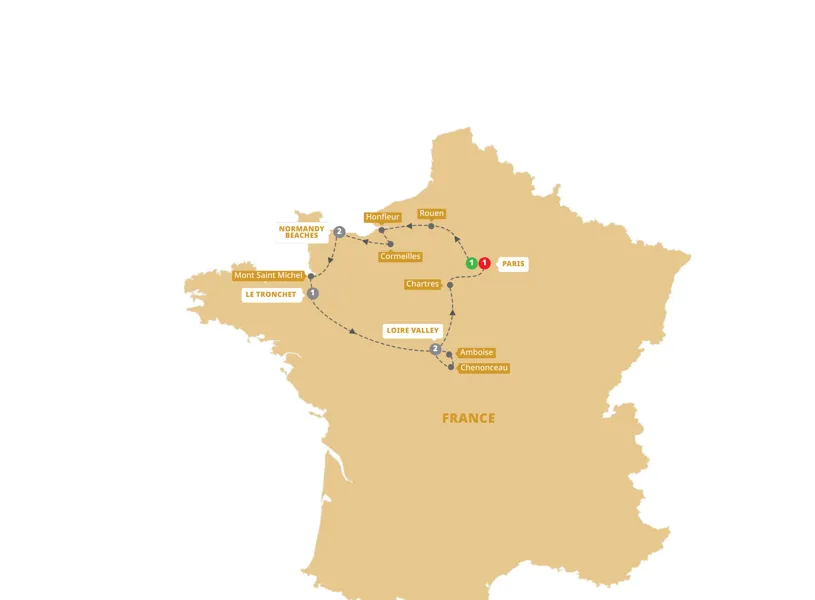
Normandy, Brittany and the Loire Valley
Day 1
Welcome to ParisDay 2
Rouen, Honfleur and DeauvilleDay 3
Normandy Beaches and D-Day LandingsDay 4
Mont Saint-Michel and Saint-MaloDay 5
Villandry ExperienceDay 6
Scenic Drive Along the Loire ValleyDay 7
La Beauce and Chartres to Paris, City of LightDay 8
Au Revoir Paris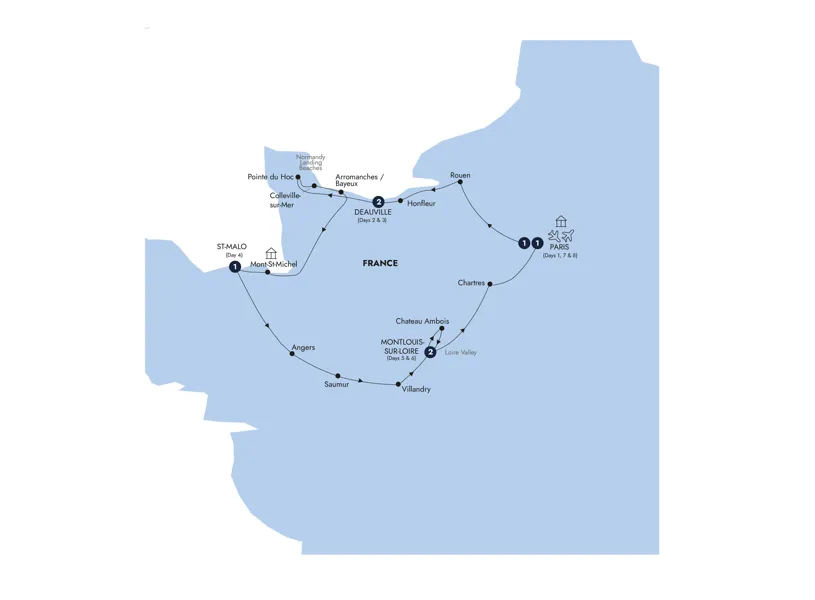
Battlefields of WWI and WWII
Day 1
Welcome to LondonDay 2
The Imperial War MuseumDay 3
The Best of BrusselsDay 4
Ypres BattlefieldsDay 5
Fromelles and Vimy RidgeDay 6
The Battlefields of the SommeDay 7
Highlights of NormandyDay 8
Normandy Beaches and D-Day LandingsDay 9
Versailles and ParisDay 10
Paris, City of LightDay 11
Farewell Paris
Remembering the Past in Poland
During WWII, the Nazi Germany invasion and occupation saw Polish citizens suffer massive land, material, and human losses. It’s estimated that 5.6 million Polish citizens, and 90% of Polish Jews, died as a result of the occupation and Holocaust. To counter the horrors in their homeland, the Polish resistance movement during the war was the largest in all occupied Europe. Together with the Home Army, Armia Krajowa in Polish, those forced to live in the ghettos attempted to fight against their oppressors.

Warsaw, Poland
While the invasion and consequential uprisings destroyed over 85% of the city of Warsaw, today you can visit the Historical Museum and walk through Old Town, entirely rebuilt since World War II. The Monument to the Ghetto Heroes, located in an area formerly a part of the Warsaw Ghetto, reminds visitors of those who fought the moving of its remaining inhabitants into concentration camps.

Oświęcim [Auschwitz], Poland
For a sobering look into what life was like for those in the camps, visitors can pay their respects in the city of Oświęcim, better known to the world in German as Auschwitz. Made up of over 40 camps and subcamps, Auschwitz contained Auschwitz II-Birkenau, the largest of these camps. 90% of those that died in the concentration camp, died in Birkenau.

Kraków, Poland
The nearby city of Kraków was the capital of the Nazi Germany General Government. What would become known as the Kraków or Podgórze Ghetto initially housed 16,000 Jews. By 1941 the Ghetto held over 24,000 people forced to give up their possessions and bring only what they could carry through the gates. The atrocities of the Jewish ghetto in Kraków and the nearby concentration camps are remembered in the film Schindler’s List and the moving monument that now stands in Podgórze, at what was the center of its ghetto.
Visit the Historical Museum and walk through Old Town in Warsaw, pay somber respect to those interred in camps in Oświęcim, and explore the Jewish ghetto in Kraków.
Bohemian Highlights
Day 1
Welcome to BerlinDay 2
Explore Bustling BerlinDay 3
Journey to Poznań and on to WarsawDay 4
Discover Historic WarsawDay 5
Onwards to Auschwitz and KrakówDay 6
See the Sights of KrakówDay 7
Venture through Slovakia to BudapestDay 8
Uncover the Treasures of BudapestDay 9
Off to ViennaDay 10
Admire Vibrant ViennaDay 11
Venture to PragueDay 12
The Old Town and More in PragueDay 13
Farewell Prague
Best of Poland
Day 1
Welcome to WarsawDay 2
Discover Historic WarsawDay 3
Onwards to Coastal GdańskDay 4
Gdańsk Your WayDay 5
Journey to Toruń and Cultural WrocławDay 6
Explore WrocławDay 7
Venture to Auschwitz and ZakopaneDay 8
Goral Life in the Tatra MountainsDay 9
Continue to KrakówDay 10
Kraków Your WayDay 11
Farewell Warsaw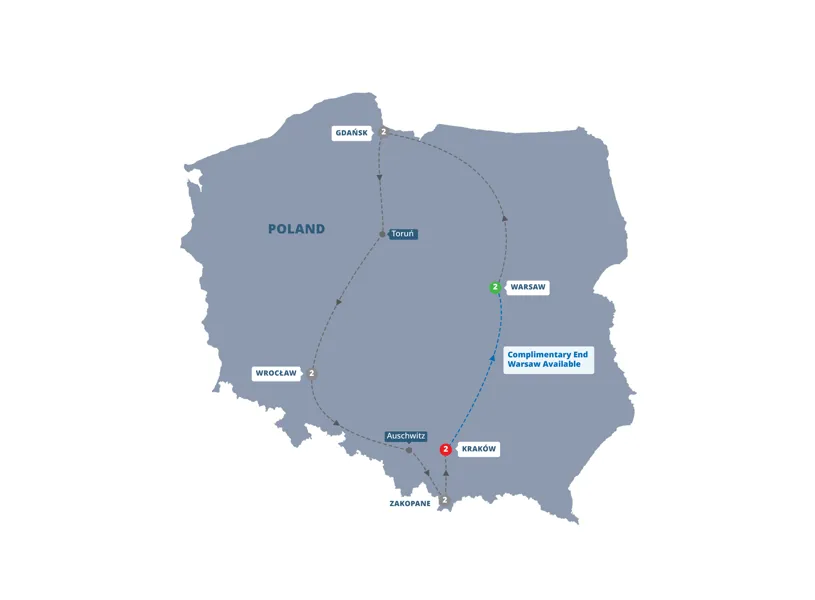
Highlights of Eastern Europe
Day 1
Welcome to ViennaDay 2
Journey to LjubljanaDay 3
Lake BledDay 4
Discover Historic ZagrebDay 5
Zagreb Your WayDay 6
Onwards to Lake Balaton and BudapestDay 7
Explore Architectural BudapestDay 8
Off to Slovakia and on to KrakówDay 9
Kraków Sightseeing and Auschwitz MemorialDay 10
On to WarsawDay 11
See the Sights of WarsawDay 12
Journey to Bustling BerlinDay 13
Uncover Berlin’s SecretsDay 14
Onwards to Dresden and PragueDay 15
Discover Colorful PragueDay 16
Through Southern Bohemia to ViennaDay 17
Farewell Vienna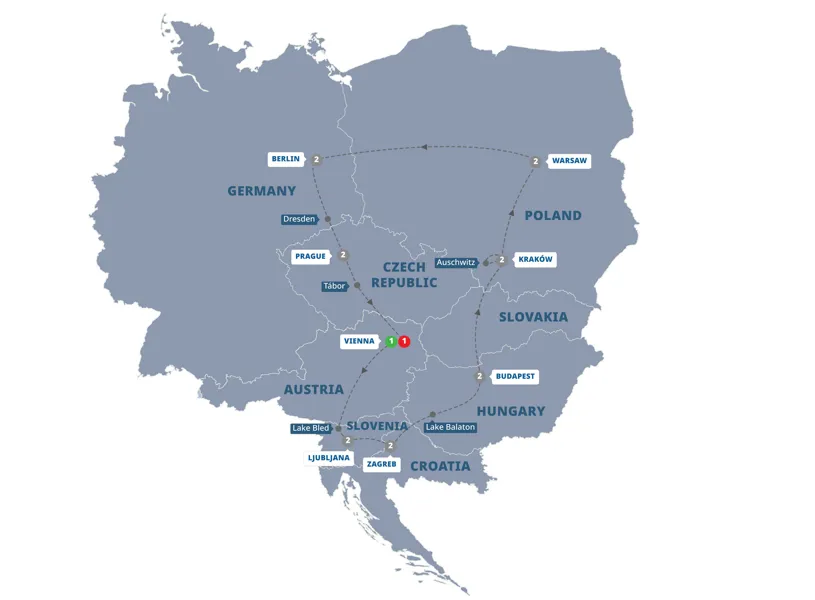
Warsaw and the Baltic States
Day 1
Arrive WarsawDay 2
Exploring the Proud Polish Capital of WarsawDay 3
Vilnius, Venerable Capital of LithuaniaDay 4
Vilnius and the Castle of TrakaiDay 5
The Votive Hill of Crosses and the Art Nouveau Nirvana of RigaDay 6
Riga Sightseeing and onto TallinnDay 7
Surrender to the Magic of TallinnDay 8
Depart Tallinn

Honoring Lives Lost in Germany
Munich
Known today for its Oktoberfest, Munich was once home to the first of the Nazi concentration camps, Dachau. What began as a place of internment for those who opposed the Nazi regime, the camp’s organization and oversight became the systematic blueprint of terror for other camps to follow. A memorial now stands on the grounds of the site, its main exhibition focuses on the path the prisoners faced in their daily lives and their journey to either death or liberation.

Berlin
Five hours from Munich lies Germany’s capital, Berlin where you can visit the Topography of Terror museum and the Holocaust Memorial to also honor victims of the past. While in town, stop by Reichstag, which was restored after the war to once again host the German Parliament.
Visit the memorial in Dachau and walk through the Holocaust Memorial in Berlin
Imperial Europe
Day 1
Welcome to MunichDay 2
Journey to Medieval Regensburg and PragueDay 3
Discover Colorful PragueDay 4
Onwards to Slovak Bratislava and BudapestDay 5
Explore Riverside BudapestDay 6
Venture to ViennaDay 7
See the Sights of ViennaDay 8
Off to Picturesque SalzburgDay 9
Return to MunichDay 10
Farewell Munich
Imperial Highlights
Day 1
Arrive MunichDay 2
Munich – Regensburg – PragueDay 3
Prague sightseeing and free timeDay 4
Prague – Bratislava – BudapestDay 5
Budapest sightseeing and free timeDay 6
Budapest – Győr – ViennaDay 7
Vienna sightseeing and free timeDay 8
Vienna – SalzburgDay 9
Salzburg – MunichDay 10
Depart Munich
Delightful Danube and Prague
Day 1
Budapest (Embark)Day 2
Budapest, EsztergomDay 3
ViennaDay 4
KremsDay 5
Engelhartszell, PassauDay 6
RegensburgDay 7
Cruising the Main-Danube Canal, NurembergDay 8
Nuremberg (Disembark), Transfer to PragueDay 9
PragueDay 10
Depart Prague
Best of Germany
Day 1
Welcome to FrankfurtDay 2
Cruise Along the Rhine and Journey to CologneDay 3
Onwards to the Port City of HamburgDay 4
Journey to BerlinDay 5
Discover the History and Icons of BerlinDay 6
Off to DresdenDay 7
Venture to Historic NurembergDay 8
Continue to Medieval Rothenburg and MunichDay 9
Explore MunichDay 10
Admire Neuschwanstein Castle and the Black ForestDay 11
On to Heidelberg and FrankfurtDay 12
Farewell Germany
Country Roads of Bavaria, Switzerland and Austria
Day 1
Welcome to ViennaDay 2
Vienna and the HabsburgsDay 3
On to SalzburgDay 4
The City of MozartDay 5
Salzburg to MunichDay 6
Explore Munich and DachauDay 7
On to InnsbruckDay 8
Beautiful InnsbruckDay 9
The Engadine Valley and Chic St. MoritzDay 10
All aboard the Glacier Express and on to LucerneDay 11
Dinner at the ‘Roof of Europe’ in StanserhornDay 12
Leave Lucerne for Zürich
Castles Along the Rhine
Day 1
Amsterdam (Embark)Day 2
Zons, CologneDay 3
Koblenz, BoppardDay 4
Boppard, RüdesheimDay 5
GermersheimDay 6
StrasbourgDay 7
Breisach (Freiburg)Day 8
Basel (Disembark)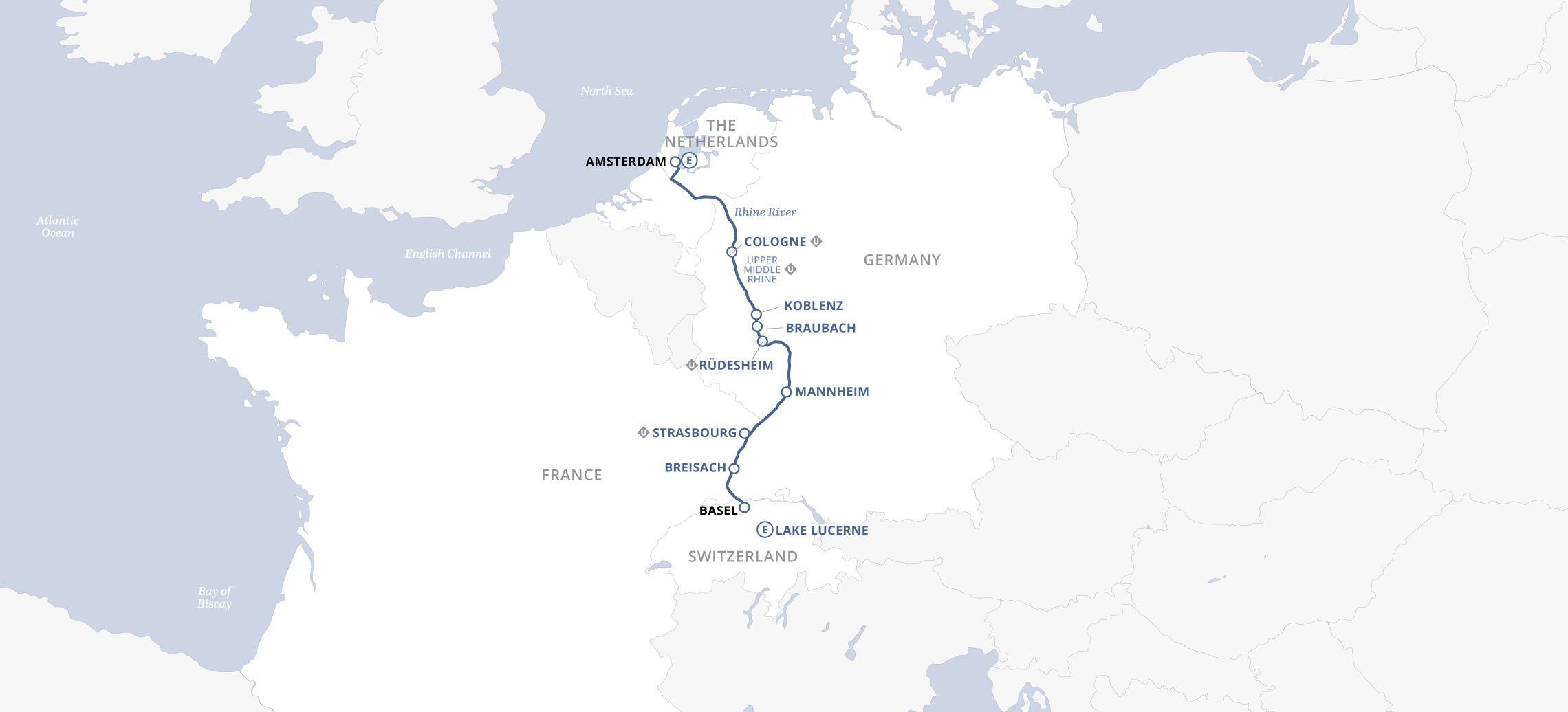
You Might Also Like
Find Your Perfect Destination
 Tap To Call
Tap To Call
 Free Brochure
Free Brochure
Order Your Free Brochure
Sign up to order your FREE travel brochure subscription and get exclusive offers only available to our subscribers
Thanks for signing up to receive our latest brochure. As a subscriber, you'll be the first to receive our new brochures as they are released, plus great deals in your inbox.






























